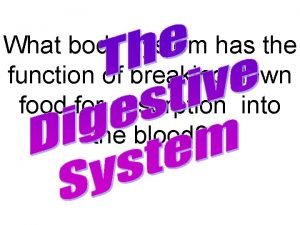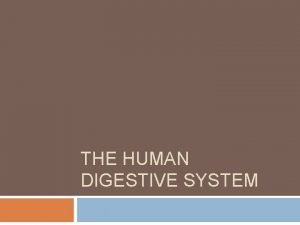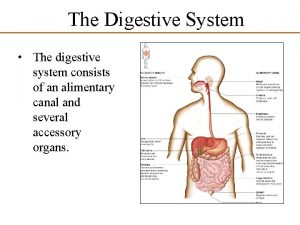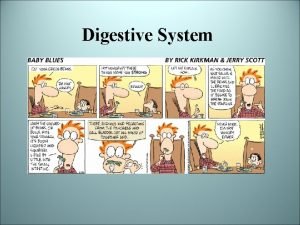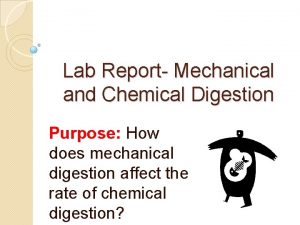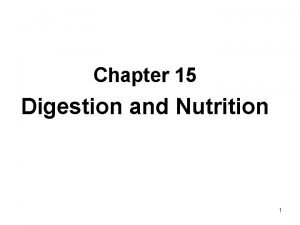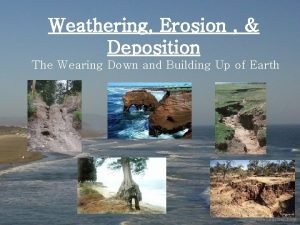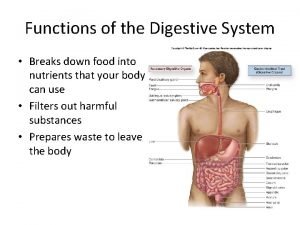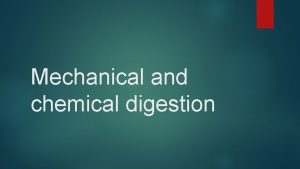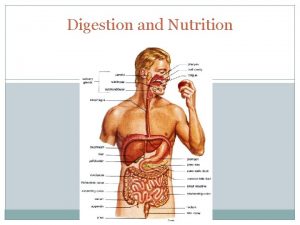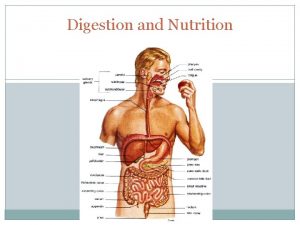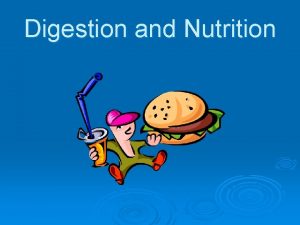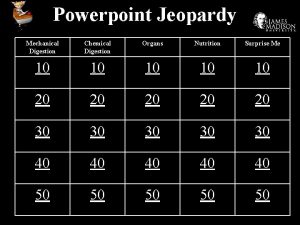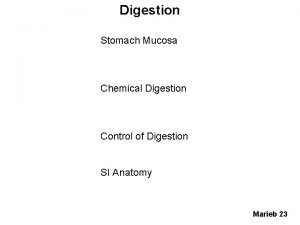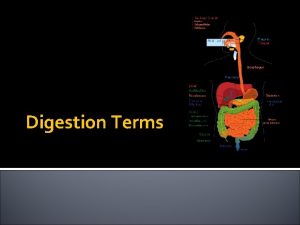Digestion and Nutrition Digestion Digestion mechanical AND chemical









- Slides: 9

Digestion and Nutrition Digestion: Digestion mechanical AND chemical breakdown of foods into… Nutrients: Nutrients food substances necessary to survive

Digestive System • Alimentary canal: from your mouth to your anus (your butthole, not the planet) – 9 meters long • Wall of the alimentary canal – Mucosa: innermost epithelial layer • Forms many folds to increase absorption – Submucosa: loose connective tissue with many glands and blood vessels—nourishes – Muscular layer: smooth muscle fibers are in circular fibers or longitudinal fibers – Serosa: secrete serous fluid so things move freely

Movements in the canal • Two basic movements: mixing movements and propelling movements • Peristalsis: Peristalsis wavelike motion • See Figure 15. 4

MOUTH • Receives food and begins digestion • Cheeks are the outer layers of skin with fat and muscles of facial expression • Lips are mobile structures that can close the mouth • Tongue fills oral cavity – Frenulum connects midline of tongue to the floor of the mouth – Papillae contain taste buds – Lingual tonsils at the root

MOUTH cont. • Palate forms the roof of the oral cavity and consists of the hard palate and soft palate • Uvula is a projection of soft palate that closes the opening between the nasal cavity and pharynx • Palatine tonsils in back of mouth • Pharyngeal tonsils (adenoids) on posterior walls of pharynx • Teeth: Teeth see table 15. 1

Salivary Glands • Secrete saliva which moistens food particles and begins the chemical digestion of carbohydrates • Amylase: Amylase enzyme that digests carbohydrates • Parotid glands: largest; found in front of ear; secrete watery fluid rich with amylase • Submandibular glands: in floor of mouth secrete a viscous fluid • Sublingual glands: smallest; secrete thick, stringy mucus

Pharynx • Cavity behind mouth • Nasopharynx: Nasopharynx passageway for breathing found behind/below nasal cavity • Oropharynx: Oropharynx opens behind the soft palate; passageway for food and air • Laryngopharynx: Laryngopharynx passageway to esophagus below oropharynx

Esophagus • Straight tube that provides passageway from pharynx to stomach • Goes through diaphragm (esophogeal hiatus) • Lower esophageal sphincter (cardiac sphincter) opens to stomach

Swallowing Mechanism • Three stages: – Food is chewed and mixed with saliva; the tongue rolls this mixture into a bolus and forces it into pharynx – Swallowing reflex • Soft palate prevents food from going up nose • Hyoid bone and larynx are elevated and epiglottis closes off trachea so you don’t choke • Tongue seals off oral cavity • Pharynx is pulled upward • Esophagus opens • Peristaltic wave begins to force food into esophagus – Peristalsis transports food in the esophagus to stomach
 Venn diagram of chemical and mechanical digestion
Venn diagram of chemical and mechanical digestion Bolus
Bolus Chemical and mechanical digestion
Chemical and mechanical digestion Chemical and mechanical digestion
Chemical and mechanical digestion Difference of mechanical and chemical digestion
Difference of mechanical and chemical digestion Chapter 15 digestion and nutrition
Chapter 15 digestion and nutrition Compare and contrast mechanical and chemical weathering
Compare and contrast mechanical and chemical weathering Mechanical and chemical weathering venn diagram
Mechanical and chemical weathering venn diagram It is where most of the absorption process happens
It is where most of the absorption process happens Mechanical digestion
Mechanical digestion
